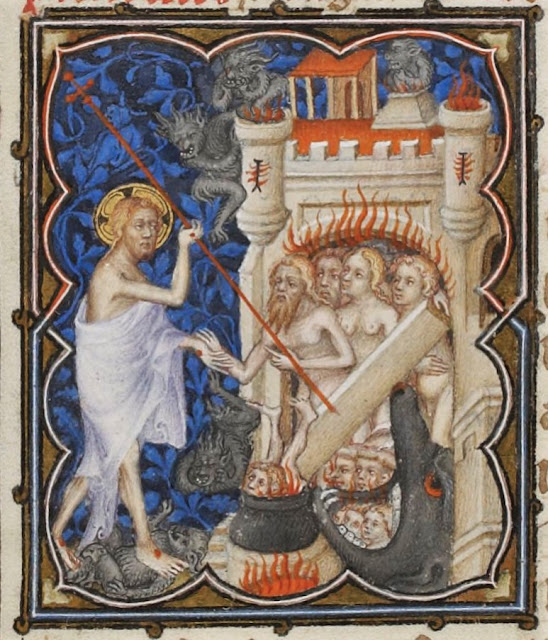 |
Luisa Roldan (called La Roldana), Rest on the Flight into Egypt
Spanish, c. 1690
New York, Metropolitan Museum of Art |
The Advent/Christmas Season has figured heavily in the history of Western Christian art from the early fourth century onward. There is a tremendous amount of material available and over the years of this blog I have written a great deal about the iconography attached to the various days and weeks. To make the material more accessible to readers I have gathered below most of these essays into a series of useful links for connecting to what I have already written on the various subjects (much as I have done for Holy Week and the Easter season).
Although the specific readings these images reflect do not form part of the liturgy in every year, each year does touch on most of them.
Please note that occasionally one or more of the essays mentioned may be unavailable at times. This is because I am attempting to keep the essays updated with new images or images that have become available in more detailed versions, thanks to improving technology and expanded access to images.
So, here goes...
Last Week of Advent/Preparation for Christmas
The O Antiphons. These are a series of antiphons (short verses that precede and follow the prayer of the Magnificat at Evening Prayer (Vespers) during the last week of Advent. They offer meditations on the significance of the Child born on Christmas Day.
The O Antiphons (introduction) click here
 |
Nativity (central group of figures) from the Metropolitan Museum Christmas Tree
Italian (Naples), Late 18th Century
New York, Metropolitan Museum of Art
|
The Annunciation
The apparition of the Archangel Gabriel to the young woman of Nazareth named Mary is the event that begins the events of the life of Jesus Christ. Therefore, the Gospel readings for Mass on the last Sunday and last week of Advent, focus on it. It has also been a principal topic for artists for many centuries, and is quite frequent on Christmas cards as well. I have written extensively on the iconography of the Annunciation and my work can easily be accessed through the guide that I put together last year.
- Links to the Iconography of the Annunciation click here
The Consolation of Saint Joseph
An angel reveals to Joseph that Mary's pregnancy comes from God, not from a man. Joseph acts on his dream and marries Mary, becoming the guardian of the Son of God.
 |
Circle of Antoine Le Moiturier, Nativity
French, c. 1450
New York, Metropolitan Museum of Art
|
The Birth of Jesus
The Nativity
Mary and Joseph are unable to find lodging in a crowded Bethlehem and find shelter in a stable (or cave) where Mary gives birth and places her child in the manger where the animals usually feed. Angels announce the good news of his birth to the shepherds in the fields, who come and adore him.
The Holy Family
Images of the three members of the Holy Family.
- Jesus, Mary and Joseph! – The Holy Family click here
 |
Altarpiece with Scenes of the Infancy of Christ
Northern French, Late 15th Century
New York, Metropolitan Museum of Art
|
The Aftermath
The Visit of the Wise Men
Wise men, led by a star, come from the East to visit the newborn child and offer him rich gifts.
- How the Image of the Wise Men Was Formed click here
The Holy Innocents
King Herod the Great knows about the prophecy of a new king in Israel. After hearing the story of the wise men he decides to ensure his throne by eliminating this new born king. So, he orders the massacre of all infant boys under 2 years old.
- The Holy Innocents – Nearly Forgotten Baby Martyrs click here
The Flight into Egypt
An angel warns Joseph about Herod's plans and orders him to take the child and his mother to Egypt to wait for Herod's death. The Holy Family flees.
- The Flight into Egypt -- The Holy Refugees, The "Simple" Images (Part I of a Series) click here
- The Flight Into Egypt -- The Variations (Part 2 of a Series) click here
- The Rest on the Flight into Egypt, Part I of 3 click here
- The Rest on the Flight into Egypt, Part II of 3 click here
- The Rest on the Flight into Egypt, Part III of 3 click here
Related Feasts
The beginning of the new year brings with it two feasts that are reflections on the Christmas story rather than narrative depictions of the Gospels. These are the Solemnity of Mary, Mother of God, on January 1 and the feast of the Holy Name of Jesus on January 3.
I wish you all a Blessed Christmas and a Healthy New Year!
 |
Christmas Tree with 18th Century Presepio
Italian, 18th Century (tree modern)
New York, Metropolitan Museum of Art |
For those of you who live in the New York area or who may be visiting, the glorious Christmas Tree with its 18th Century Italian Presepio figures (sometimes known as the Angel Tree) is again on view. This year it can be visited until January 7, 2024. As always, it is well worth the visit.
© M. Duffy, 2021, 2022 2023.






_Hours%20of%20Rene%20of%20Anjou_France_Paris)_1410_BL_Egerton%201070,%20fol.15v%20det.jpg)

















